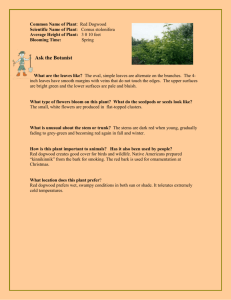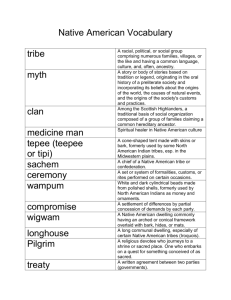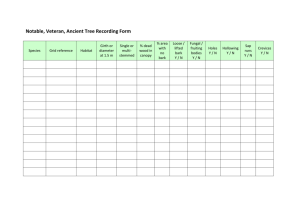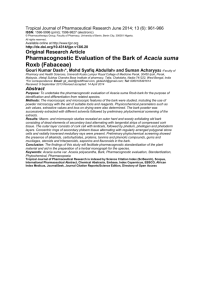Common Trees of Alabama
advertisement
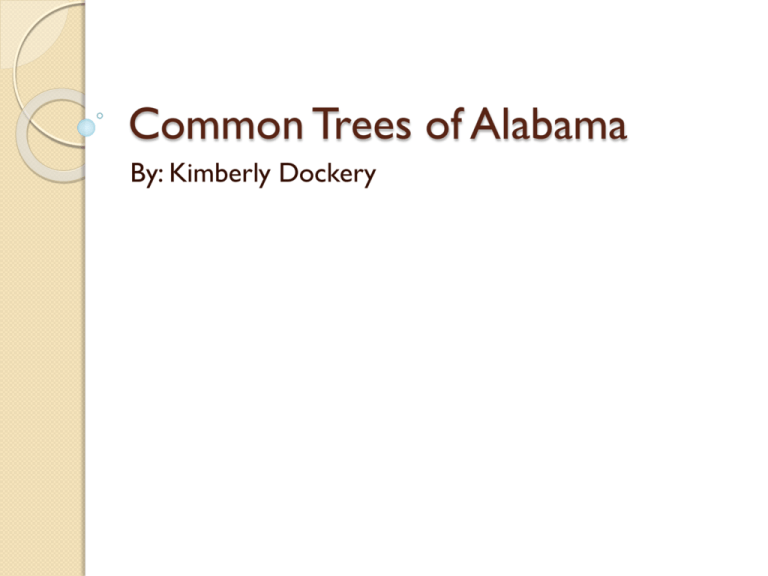
Common Trees of Alabama By: Kimberly Dockery Northern Red Oak The Northern Red Oak is an important source for hardwood lumber. It is native to the Northeastern United States and southern Canada, and lives as far south as southern Georgia and Alabama. The leaves on the Northern Red Oak are elliptical shaped with seven to eleven shallow lobes. The upper side of the leaf is a dull green with a dull light green underside that has tufts of hair in angles along the mid-vein. In the fall, the leaves of this deciduous tree turn brown or a dark red. The bark of this tree is a dark grey or blackish color. It is rough and furrowed with scaly ridges. The inner bark of this tree is reddish in color. Wood harvested from this tree is often used for flooring, furniture, railroad cross ties, fence posts, and pulpwood. In forest stands, the Northern Red Oak begins to bear fruit about age 25. The acorns are between 5/8 to 1 1/8 inches long and are egged shaped. The cup is reddish brown with tightly overlapping scales. It takes two years for the fruit to mature. Southern Red Oak The Southern Red Oak is a deciduous tree primarily found in the southeastern United States. However, it can extend as far north as southern New Jersey and Ohio and has far south as Florida, and as far west as Oklahoma. Leaves on the Southern Red Oak are dark green and smooth on the upper side. The underside of this leaf has yellowish hairs. Leaves can either have three lobes, which is found on younger trees or five to seven lobes. It is often identified by its inverted bell-shaped leaf base as seen in the picture. The coarse grain wood of this tree is often used for lumber, flooring and some furniture making. Bark on this tree is thick and is brownish black in color. It is deeply furrowed with small pebbly scales. The fruit on the Southern Red Oak is a nearly globe-shaped acorn. It is about 1/2" long with a slightly hairy, saucer-shaped cup. It takes two years for the fruit to mature on this tree. White Oak The White Oak is native to eastern North America. This span covers all the way north to southern Quebec and as far south as northern Florida. It can be found as far east as Minnesota and as west as eastern Texas. Leaves on the White Oak have a deep dark green upper surface and often turn red or even purple in the fall. The undersides of these leaves are light green in color. The leaves have seven to nine lobes and are oblong in shape. In the spring, when the leaves first begin to appear, they are soft pink in color. The bark color can vary from dark grey to white. It is often appears fissured and scaly. Smooth patches are not uncommon on mature trees. The bark can also have a “scaly” appearance as seen in this picture as the tree ages. When cut, the wood has a light color and is often used for flooring because it is very strong. The acorn of the white oak is oblong and the bowl shaped cap covers ¼ of the fruit. Maturity takes one growing season and the cap always detaches at this time. Hickory The hickory is known for is hard wood and is often used to make tools and equipment. It is also used when cooking meat to give it a smoky taste. The hickory tree is in the walnut family. There are 17-19 species of Hickory trees and about a dozen of these trees are native to North America. Hickory leaves have a compound structure. The amount of leaflets found depends on the species. The top side of the leaf is generally a dark green with a lighter green underside. The leaves turn bright yellow in the fall. The bark of the hickory tree varies from tan to grey in color depending on the species and has an angled pith. With most species of hickory, when the tree is young, the bark is smooth. As the tree ages, the bark develops scaly ridges. The fruit of the hickory has a globular or oval nut. The fruit has a four-valved husk that is about a ¼ inch thick and naturally opens in the fall upon maturity. Sweetgum The sweetgum tree is second in production to the oak family. The wood is used for flooring, furniture, and for paper pulp which is often used to make baskets. Long ago, pioneers scraped a resin-like solid from the bark to make chewing gum. The sweetgum tree is easily identifiable by its star-shaped leaf. The leaves are dark and glossy on top and paler on the underside with little hairs. The leaves alternate with five to seven lobes. In the fall, the leaves turn yellow, red, orange, and purple. The bark of the sweetgum tree is grey in color. Young sweetgum trees have smooth bark with warty projections. As the tree ages, the bark becomes deeply furrowed separated by scaly ridges. Twigs and newly formed branches of the sweetgum have a corky appearance. The fruit of the sweetgum tree are spiky green balls that turn brown with age. They are a little over an inch wide. Each prickly point opens to let seeds out. Up to 50 seeds can be found in one fruit. The seeds are often distributed by the wind. Dogwood The dogwood tree is known for its beauty. It can live up to 80 years and is native to Eastern North America. There are about 30-50 different species of dogwoods. The leaves on the dogwood tree have a bright green surface and a pale green underside. They are oval in shape and grow approximately five inches long and two inches wide. In the fall, the leaves turn a beautiful purple color. The dogwood tree blooms in the spring and is known for its striking flowers that are usually yellow or white in color with rust-colored tinted tips. The flowers consist of a yellow cluster of flowers in the middle surround by pedal-like bracts. Flowers stay on the tree for two to three weeks. Following the flowers are bright red football shaped fruits about a 1/2 inch long. The fruit is loved by birds and other small animals. The bark on the dogwood tree resembles that of alligator skin. It has reddish brown or reddish grey patches separated by fissures. The bark of the dogwood was formally used by Native Americans to reduce fevers. Wood from this tree is highly resistant to cracking. Yellow Poplar The yellow poplar is also often called a tulip tree and is a member of the magnolia family. The average height of this tree is 70 to 90 feet. The leaves are tulip shaped, alternate, and simple. There are four lobes on the leaves and each lobe is separated by notches. The leaf is smooth on both surfaces. The leaves are dark green above and a lighter or pale green underneath. In the fall, the leaves turn bright yellow or gold in color. Once the tree is 15 years old, it begins the flowering process. From April to June, this tree produces a tulip shaped light greenish-yellow flowers. The cone shaped fruit, clusters usually persist on branches. The flowers are often hard to see because they emerge in the upper part of the tree’s canopy. The bark on younger trees is often smooth and light ashy grey in color with very shallow light furrows. With age the bark becomes very thick having deep interlacing furrows and narrow rounded ridges. The wood from this tree is fine grained and used for cabinets and furniture framing. Shortleaf Pine The shortleaf pine is native to the Eastern United States and can be found in 22 states. This conifer tree can reach heights up to 100 feet tall. The needles form in bundles of two or three mixed together and are about three to five inches long. The needles are dark yellow green in color and are flexible. The bark is scaly and dark on young trees which eventually turn into flat scaly plates.Very small resin pockets may be present within the bark. The shortleaf pine does not generally bear seeds until 20 years of age. The fruit of the shortleaf pine is a cone that is greater than an inch long. The cone is oblong in shape and is wider at the base than at the tip. It is also hard and dry with scales and spines. This tree is important to commercial timber. The wood is used for carpentry, construction, as well as for the manufacture of various wood products. Loblolly Pine Since the growth rate for this tree is rapid, it is prized for lumber and pulpwood. It is the most commercially important forest species in the southern United States. This tree grows to a height of 90-110 feet tall. The dark green needles of this tree are in bundles of three and grow five to nine inches long. The needles usually last up to two years before they fall. They are generally stiff and sometimes slightly twisted. The seed cones for the loblolly pine are green, but when ripened turn rusty brown in color. They are three to five inches in length and 1 to 1.5 inches wide. At the tip of each scale there is a sharp spine. Cones drop their seeds in fall or winter, but remain on the tree for another year. Mature bark is thick and bright reddish brown in color and divided by small fissures into broad flat topped plates covered with thin scales.
